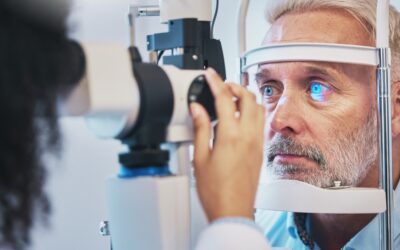Table of Contents
6 MIN. READ
We often associate decreasing vision with aging, but eye health issues are common in school-age children. As an educator, you can make a difference by familiarizing yourself with common symptoms caused by vision problems. You can also connect families to local resources to make screenings, exams, and prescription eyeglasses more accessible.
Addressing vision problems early gives students the tools they need to thrive in an academic setting. Here, you’ll learn how to spot eye health problems and connect parents to resources available in Oklahoma.
Vision is critical to learning. Many states require students to have vision exams and to bring to school corrective lenses. While we work on that legislation to support you, here are some excellent resources and ways to detect poor vision with your students.
How Does Vision Impact Learning?
Many aspects of academic learning rely on vision. Whether it’s reading exercises, written tests, or homework, students engage with books or screens throughout their school day. Issues with distance vision can make it difficult to read what’s on the whiteboard or smart board, making students feel left out and disengaged.
For students who struggle with close vision, reading and writing tasks become difficult. Children can quickly lose interest, struggle to make sense of what they’re reading, and make mistakes. Vision issues cause children to miss out on an increasing quantity of information and eventually fall behind academically.
How Common Are Vision Problems in Students?
Refraction errors could affect as many as 20% of children. Other sources claim that one in four children has an undiagnosed vision problem. Nearsightedness and farsightedness are among the most common refraction errors, but some children suffer from astigmatism, amblyopia, lazy eye, or strabismus, also known as crossed eyes.
Recent studies also suggest that nearsightedness is on the rise among children due to a combination of genetic and environmental factors. A study found that this condition could affect as many as 36% of children.
Why Vision Problems Can Be Difficult to Spot
Some vision problems are difficult to detect because the symptoms can mimic a learning disability. Poor vision often causes students to develop short attention spans. In some cases, feeling frustrated or disengaged from academic activities can lead to behavioral problems.
Children don’t usually realize the problem comes from their eyes because they’ve grown accustomed to living with a refractive error. These eye health conditions typically progress slowly and don’t result in drastic changes that would be noticeable.
Top Eye Health Symptoms to Watch Out For
Teachers interact with students daily and can help spot those who may benefit from an eye exam by looking out for these physical symptoms:
-
Your student’s eyes might look red, irritated, or swollen.
-
You might notice tearing or drainage from the eyes.
-
The child might squint and blink, especially when the light is bright.
-
Misaligned eyes, crossed eyes, and lazy eyes are usually easy to notice.
-
Eye strain is common in children with vision problems. It can cause children to rub their eyes a lot.
-
Headaches affect 20% of students. Eye-related headaches might appear after a child has been focusing on a task for a while.
However, many students with refraction errors display physical symptoms. Instead, they will adopt new habits to compensate for their blurry or double vision:
-
Students with nearsightedness cope by holding reading material closer to their faces or hunching over their desks.
-
Some will compensate for their farsightedness by holding books at arm’s length.
-
In some cases, reading with one eye may be easier, so they may tilt their heads or cover one eye to favor the side with the good eye.
Poor vision often affects academic performance. These symptoms might be your first clue that your student needs an eye exam:
-
Students with eye health problems often develop short attention spans.
-
They might skip words or letters when reading aloud.
-
Their reading comprehension is below average.
-
They seem to miss or overlook written instructions.
The Importance of Regular Eye Screenings and Exams
Regular screenings and exams can help detect eye health problems before they affect a child’s academic performance. However, screenings are different from exams.
A screening will usually measure a child’s visual acuity and include a physical inspection of the eyes. It’s less comprehensive than an exam, but it’s a helpful step for identifying students in need of more advanced testing.
During an eye exam, an optometrist can perform advanced visual acuity, refraction, and eye movement tests. An exam can also include checking for eye diseases or using topography equipment to measure the cornea’s curvature. An eye exam is necessary to obtain a diagnosis and get a prescription for eyeglasses or contacts.
The American Optometric Association recommends annual exams for most school-age children. As a teacher, you can remind parents of the importance of scheduling an annual exam when sending out your back-to-school supply list.
Eye Health Resources for Oklahoma Students
For some families, eye exams and prescription eyeglasses can be an additional expense that is difficult to cover. You can make a difference by connecting parents with these resources designed to make eye health accessible through free or low-cost programs.
Vizavance
Previously known as Prevent Blindness Oklahoma, Vizavance is a non-profit that provides free screening services in public and private schools. If you don’t see your school listed in the organization’s calendar, talk to your school board about reaching out to Vizavance.
Oklahoma Association of Optometric Physicians (OAOP)
Members of the OAOP offer free or affordable services through low-income clinics. The eligibility requirements can vary from one clinic to another, but this helpful online tool will help you connect parents with ten clinics in Oklahoma City and two clinics in Tulsa.
Community Health Centers
While not all community health centers offer eye care services, some organizations have free or low-cost programs. Locate the nearest community health center to find out more about the options available in your area.
National Association of Free and Charitable Clinics
The NAFCC provides free or affordable healthcare services. There are around 50 participating clinics in Oklahoma, and some of them offer eye health services.
Lions Clubs International
Lions Clubs International is a service organization with several programs designed to help communities, including free eye screenings and exams. With 11 clubs throughout Oklahoma, your nearest Lions Club might offer this service.
New Eyes
Once a student has a prescription, they can fill out an application through New Eyes to qualify for free eyeglasses. Patients can apply themselves, but it’s usually best to inform a healthcare provider or social service worker of this program so they can fill out an application on behalf of the recipient.
Chickasaw Nation
In partnership with Oklahoma Optical, the Chickasaw Nation offers a $200 allowance towards eyeglasses or contact lenses to students who are Chickasaw Nation citizens.
Cherokee Nation
The Cherokee Nation in connection with The College of Optometry at NSU offes free Eye Exams and offers a $200 allowance towards eyeglasses or contact lenses to students who are Chickasaw Nation citizens.
Choctaw Nation
The Choctaw Nation offers plus free Eye Exams plus has a large selection of frames for students who are Choctaw Nation citizens.
Muscogee Creek Nation
The Muscogee Creek Nation offers free Eye Exams and a $250 allowance towards eyeglasses to students who are Muscogee Creek Nation citizens.
Indian Health Services (IHS)
IHS has many clinics in different parts of the state and offers free eye exams and glasses to students who are Chickasaw Nation citizens.
InfantSEE
Families with children between six and twelve months of age can qualify for free eye exams through participating InfantSEE providers.
Vision Screening Providers
Sharing this list of approved vision screening providers for the state of Oklahoma can help parents explore different options and find affordable eye screenings in their area.
Essilor
Essilor has a program called the OneSight Foundation that provides free glasses for children who cannot afford glasses.
How Vision Care Direct of Oklahoma Can Help
Give your students and their families access to the eye health resources they need for academic success. Contact Vision Care Direct of Oklahoma to learn more about local resources and affordable eye care services for families! If you have a child that does not qualify for any of the programs above, contact us and we will find the resources or pay for them ourselves.
We hope this Resource Guide will be valuable to you. If you have any questions feel free to reach out at anytime.






















































